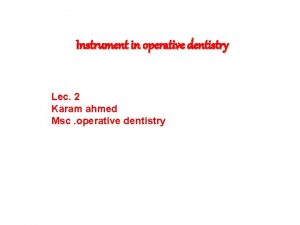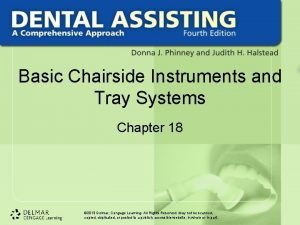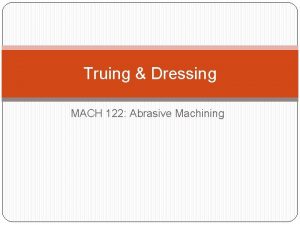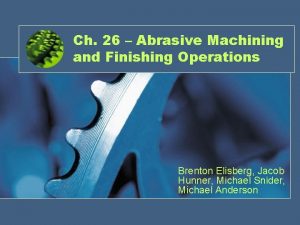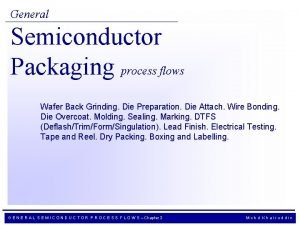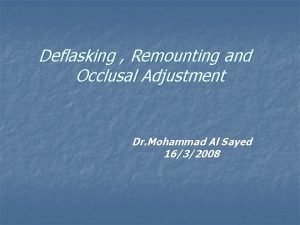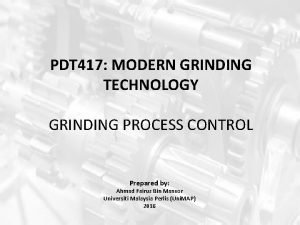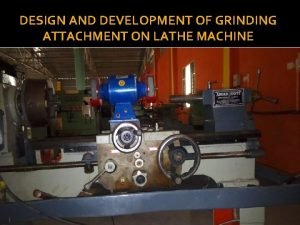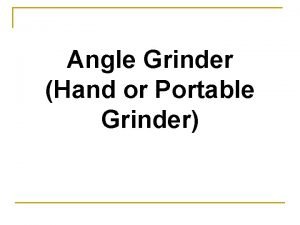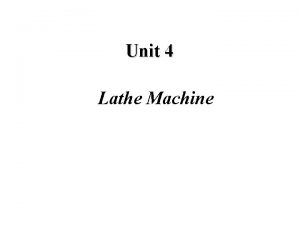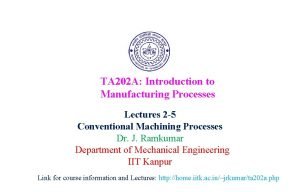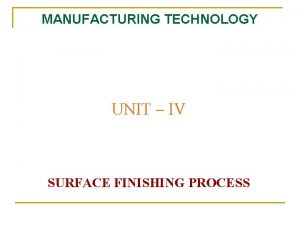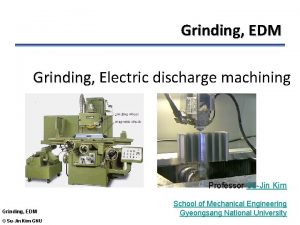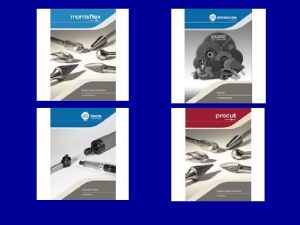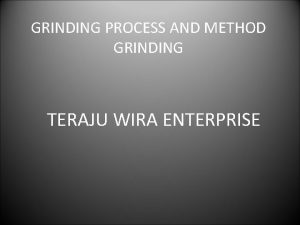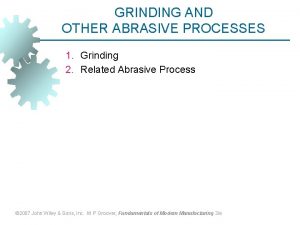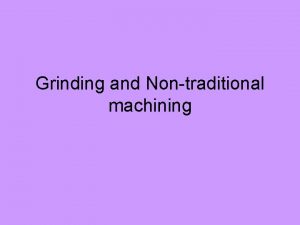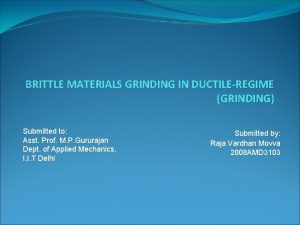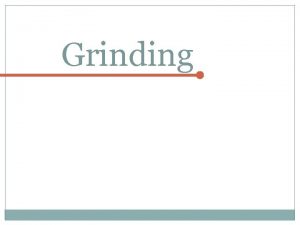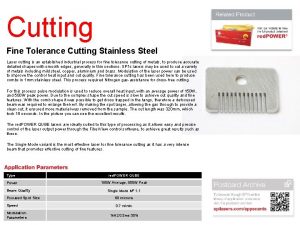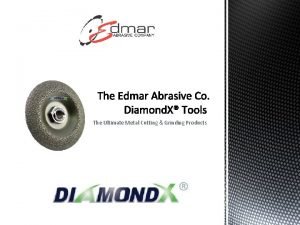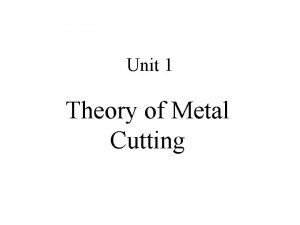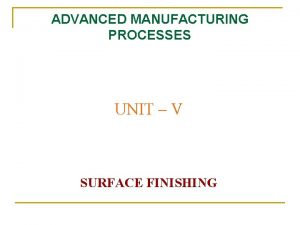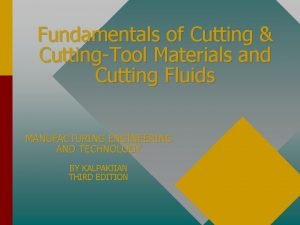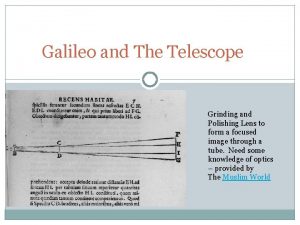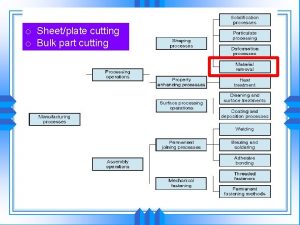UNIT 8 CUTTING AND GRINDING Unit 8 Cutting























- Slides: 23

UNIT 8: CUTTING AND GRINDING

Unit 8: Cutting & Grinding Lesson 3: Fundamentals of Lathes

COURSE INFORMATION Unit 8: Cutting & Grinding • • Lesson 1: Saws Lesson 2: Fundamentals of the Vertical Milling Machine Lesson 3: Fundamental of Lathes Lesson 4: Surface Grinders Lesson Description In this lesson, you will be introduced to the fundamentals of a lathe machine. In the lecture component, you will learn about a lathe’s primary uses, how a lathe works, its features, and safety guidelines. In addition to the lecture, depending on shop availability, an instructor may lead you through a lathe project. 3

LESSON OBJECTIVES Following this lesson, the student will be able to: Describe the features of an engine lathe. Identify the primary uses of a lathe. Describe a lathe’s operating procedure. Demonstrate knowledge of the safety SOP’s of a lathe. • Use appropriate tooling to produce the project part. • • 4

FUNDAMENTALS OF A LATHE Features How a Lathe Works Primary Uses CNC Lathes Lathe Safety Guidelines 5

LATHES • The precision metal lathe or standard lathe is the 2 nd of 3 standard tool room machines that are used in the production of precision machined parts. • Metal lathes have a history in metal working that goes back over 100 years. 6

PRIMARY USES • To “Turn” or machine round parts. It can machine long or short cylindrical pieces. • Accurately turn outside diameters, inside diameters, cut threads, drill, bore holes, ground and knurl surfaces. • Lathes can work with all metals including steel, aluminum, brass, copper, plastic, wood and composite materials. 7

HOW LATHES WORK • Lathes use a single point tool usually made from high speed steel or carbide. • The part is loaded into a round vise-like clamping device called a chuck. • The jaws of the chuck collapse upon the outside of the material and hold it from slipping while machining. • The lathe is turned on to a set RPM and the piece clamped into the chuck rotates. • While the part is rotating and is moving across the lathe, a single point tool bit is subtracting material. Videos: From Machine Tool Basics – Smithy Granite Intro to Lathe Operations (2: 48) ttps: //www. youtube. com/watch? v=H 0 Ay. VUfl 8 -k Lathe Workholding (4: 52) https: //www. youtube. com/watch? v=Q 7 QUi. CJJmew Lathe Cutting Tools (4: 05) https: //www. youtube. com/watch? v=Q 7 QUi. CJJmew 8

LATHE Headstock Tailstock Carriage 9

FEATURES OF LATHES: HEADSTOCK H 1: Headstock H 2: Speed Change Mechanism H 3: Speed Change Mechanism H 4: Main Spindle H 5: Operate Tumbler Gears H 6: Quick Change Gearbox H 7: Leadscrew H 8: Feedscrew (long driveshaft) H 9: Feedscrew H 10: Change Gears The headstock houses the main spindle, speed change mechanism and change gears. 10

FEATURES OF LATHES: CARRIAGE Tool Holder Compound Rest Cross Slide The carriage holds the tool bit and moves it longitudinally or perpendicularly under the control of the operator, who is controlling it using the handwheel. 11

FEATURES OF LATHES: TAILSTOCK • Most lathes have a feature called a tailstock that can hold different tools. These tools can be used to drill holes into the center of the work piece or tap threads. • The tailstock can be used to support long work pieces while machining. • The tailstock is located opposite the headstock. The spindle doesn’t rotate, but it does travel guided by the handwheel. 12

FEATURES OF LATHES: TAILSTOCK T 1: Handwheel (guides the spindle) T 3: Tailstock body T 4: Base - Can offset the tailstock from the spindle’s axis. T 5: Spindle T 6: Clamp control 13

FEATURES OF LATHES: 2 -AXIS • Lathes are 2 -axis machine tools. The X-axis is what determines the diameter of the work piece (from the outside surface to the center of the part). • The 2 -axis determine the length of the part from the right face surface to the chuck on the left side of the machine. 14

FEATURES OF LATHES: 3 & 4 JAW CHUCK The chuck on a lathe is unique compared to drill chucks and mill vises. 3 Jaw Chuck 4 Jaw Chuck 15

FEATURES OF LATHES: SFM • Lathes can turn parts as slow as 50 RPM or as fast as 2500 RPM. One of the key lathe formulas to calculate is the SFM (Surface Feet Per Minute). It means how much material is moving past the tool bit in 60 seconds. • As a rule you want large diameter parts to run at a slower RPM, and smaller diameter parts to run at a faster RPM. This keeps the SFM constant, preventing it from overheating, and wearing down the sharp tool bit permanently. Video: Lathe at 154 RPM (0: 30) https: //www. youtube. com/watch? v=c. Pj. Uoh-2 Aj. Q 16

CNC LATHES CNC Lathes have been replacing the older lathes. Their production benefits include: • • Production Time Reliability Repeatability Accuracy 17

CNC LATHES It is controlled using a computer interface which requires a high level of training to use. 18

CNC LATHES 19

SOP’S OF A METAL LATHE 1. All stock must be properly secured in the lathe chuck or mounted prior to the machining process taking place. Use the correct sized clamp or vise for the stock being machined. 2. Turn the chuck or faceplate by hand to ensure there is no binding or danger of the work striking any part of the lathe. 3. Check to ensure the cutting tool will not run into the chuck or lathe dog. If possible, feed away from the chuck or dogs. 4. Before starting the lathe, ensure the spindle spins freely; the tail, stock and tool rests are securely clamped; and there is proper clearance for the rotating stock. 5. Prior to starting the lathe, ensure that small diameter stock does not project too far from the chuck without support from the tail stock center. 6. When roughing stock, do not force the tool in the work piece or take too big a cut. 7. The operator must always be aware of the direction and speed of the carriage or crossfeed prior to engaging the automatic feed. Never leave the key in the chuck. Do not let go of the key until it is free of the chuck and secured in its proper holding place. 8. Select turning speed carefully. Large diameter stock must be turned at a very low speed. Always use the lowest speed to rough out the stock prior to final machining. 9. The correct speed and feed for the specific material and cutting tool must be used. Stop the machine before making adjustments or measurements. 20

SOP’S OF A METAL LATHE, CONT’D. 10. Do not remove metal or wood chips from the table or stock by hand. Use a brush or other tool to properly remove chips or shavings from the table or stock. 11. Never attempt to run the chuck on or off the spindle head by engaging the power. 12. Do not stop the rotation of the chuck by reversing the power to the lathe, unless tapping holes. 13. Do not leave tools, bits or excess pieces of stock on the lathe bed. 14. All belts and pulleys must be guarded. If frayed belts or pulleys are observed, the lathe must be taken out of service and the belts or pulleys replaced. 15. Stop the machine immediately if odd noise or excessive vibration occurs. 16. Only properly sharpened drill bits and cutting tools in good condition should be used. Dull drill bits and chipped or broken cutting tools must be removed from service. 17. Disconnect the lathe from power source and see OSHA Lock-out/Tag-out Fact Sheet if making repairs or servicing. 18. When an operator has finished working on the lathe, and before leaving the lathe for any reason, the power must be shut off and the machine must come to a complete stop. 19. When an operator observes an unsafe condition with the lathe or stock being worked, the operator must report it immediately to the designated Machine Shop Safety Administrator, and the lathe must be taken out of service until the problem has been corrected. 21

SUMMARY The lathe can be mastered with a little practice and patience. It is an excellent machine tool for turning round materials and has been a standard in machining for years. 22

Acknowledgements Aerospace Joint Apprenticeship Committee (AJAC), American Society of Metals (ASM), The Boeing Company, National STEM Consortium (NSC), Skills Inc. , Washington Manufacturing Advanced Training Institute (WMATI) About These Materials Copyright © 2015 by Washington Manufacturing Advanced Training Institute (WMATI) The Core. Plus: Manufacturing Skills Curriculum is a collaboration among Boeing and WMATI License Unless otherwise specified, this work is licensed under a Creative Commons Attribution-Share. Alike 4. 0 International License. Attribution and Citation To attribute this course please reference Washington Manufacturing Advanced Training Institute (WMATI). Some of the slide deck, activities, and lab projects are derivative works used under CC-BY 4. 0. National Stem Consortium. (2015). Machine Operations Lab and Machine Tool Theory. Composites Technology certificate program of the National STEM Consortium. Retrieved from http: //oli. cmu. edu. Some slide decks, activities, and lab projects are derivative works used under CC-BY 4. 0. Aerospace Joint Apprenticeship Committee. (2015). Manufacturing Academy. To cite this course please use the following citation example: Washington Manufacturing Advanced Training Institute (WMATI). Core. Plus Manufacturing Skills Curriculum: Precision Measurement course. [URL if applicable. ] Core. Plus, 2015. Disclaimer This workforce solution was built from open license materials from many sources. There are no guarantees, warrantees, or assurances of any kind, express or implied, with respect to such information, including any information on linked sites and including, but not limited to, accuracy of the information or its completeness, timeliness, usefulness, adequacy, continued availability, or ownership.
 Which part of the lathe machine is called dead centre mcq
Which part of the lathe machine is called dead centre mcq Enamel hatchet instrument formula
Enamel hatchet instrument formula Cutting and non cutting dental instruments
Cutting and non cutting dental instruments Cutting and non cutting dental instruments
Cutting and non cutting dental instruments Simultaneous grinding and spray drying
Simultaneous grinding and spray drying Dressing and truing
Dressing and truing Finishing operations
Finishing operations Cutting tools in sewing with pictures and meaning
Cutting tools in sewing with pictures and meaning Orthogonal cutting is dimensional metal cutting
Orthogonal cutting is dimensional metal cutting Remounting
Remounting Wafer process flow
Wafer process flow Selective grinding
Selective grinding Advantages of balanced occlusion
Advantages of balanced occlusion Grinding process control
Grinding process control Surface grinding attachment
Surface grinding attachment Parts of portable disc grinder
Parts of portable disc grinder Carriage grinding machine
Carriage grinding machine Lathe gore
Lathe gore Ta 202
Ta 202 Surface finishing operations in production technology
Surface finishing operations in production technology Sequelae of wearing complete denture slideshare
Sequelae of wearing complete denture slideshare Edm grinding
Edm grinding Ata grinding processes ltd
Ata grinding processes ltd Optimization of cylindrical grinding process parameters
Optimization of cylindrical grinding process parameters


